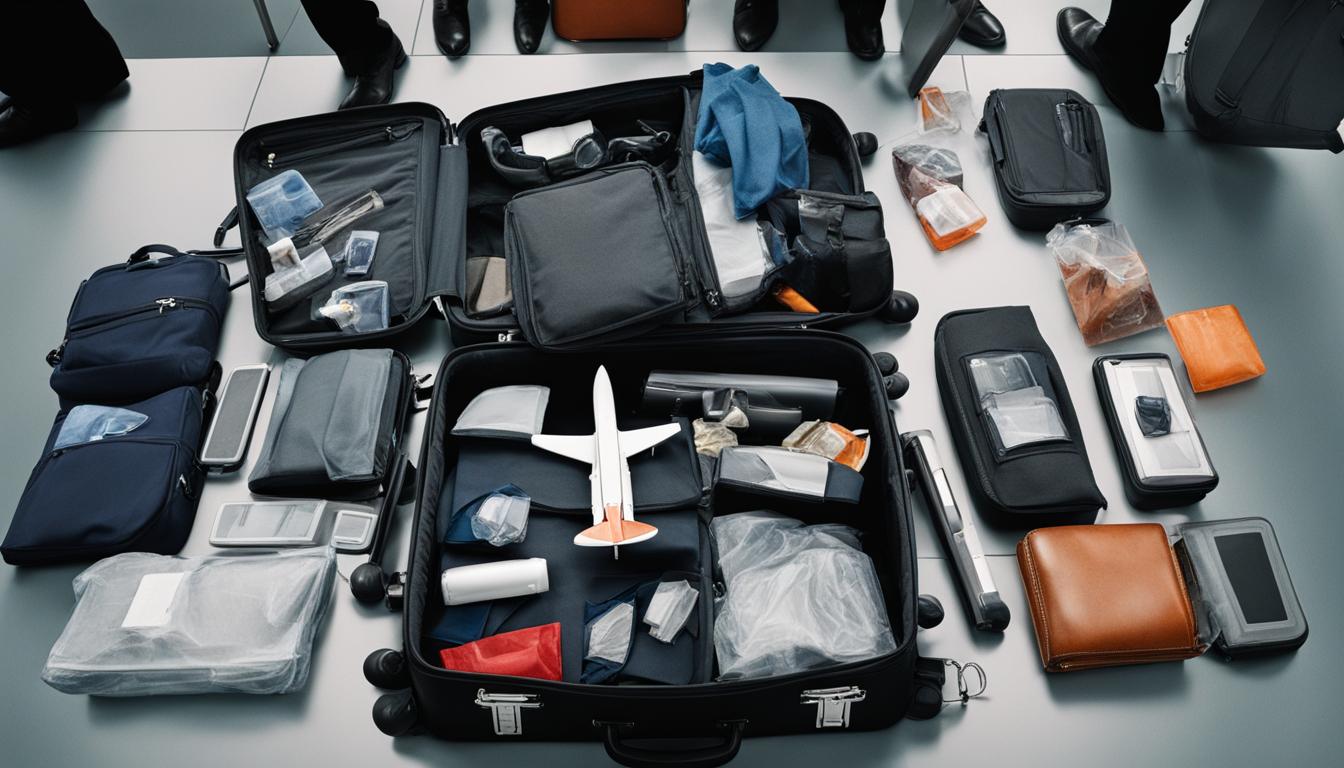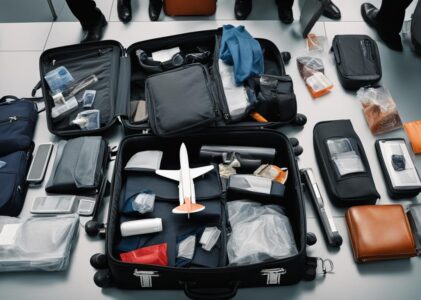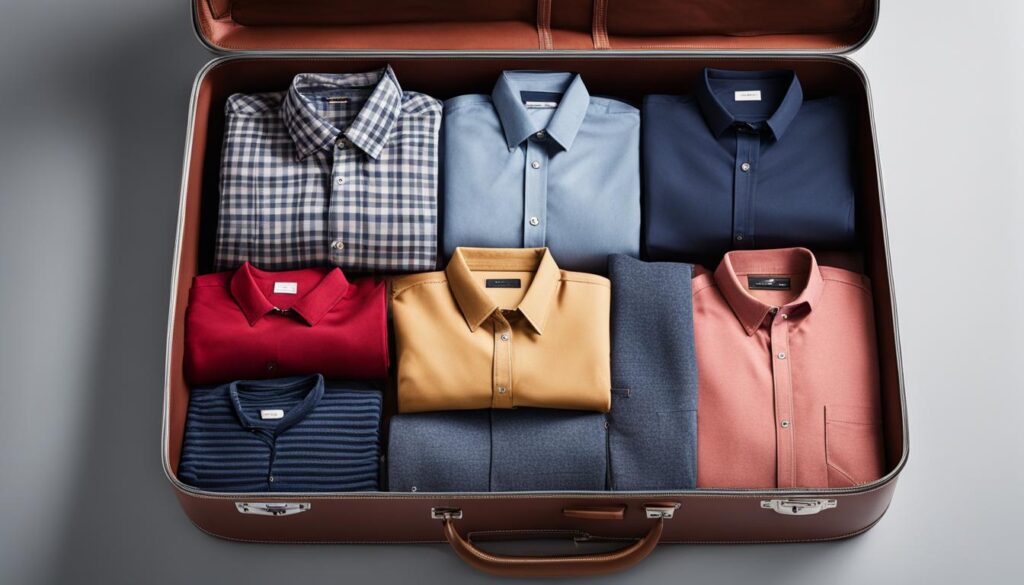The Transportation Security Administration (TSA) has specific rules and regulations regarding what items are prohibited from being brought on a plane. It’s important to be aware of these restrictions to ensure a smooth travel experience. Here are some essential travel tips and a list of items that you cannot bring on a plane, based on TSA regulations.
Key Takeaways:
- Understanding TSA regulations for carry-on is essential for air travel.
- Prohibited items in carry-on bags include sharp objects, firearms, and flammable substances.
- Liquids, gels, and aerosols must adhere to specific guidelines and be in containers of 3.4 ounces or less.
- Additional restrictions apply to small tools, electronic devices, and medications.
- Some items, like wedding dresses and pets, have special instructions that vary by airline.
Prohibited Items in Carry-On Bags
When it comes to packing your carry-on bag for air travel, it’s important to be aware of the items that are strictly prohibited. These restrictions are in place for the safety and security of all passengers onboard. Here is a list of items that you cannot bring in your hand luggage:
- Sharp objects: Knives, box cutters, ice picks, and other similar items are not allowed. These can be potential weapons and pose a threat to the safety of passengers.
- Firearms and ammunition: Bringing firearms or any type of ammunition on a plane is strictly prohibited. These items should be stored securely and declared to the airline if necessary.
- Explosive materials: Items like fireworks and explosive substances are not permitted in carry-on bags. These can cause significant harm and disruption to the aircraft.
- Flammable substances: Gasoline, lighter fluid, and other flammable liquids are not allowed. These pose a fire hazard and could potentially lead to an emergency situation.
- Self-defense items: Pepper spray, martial arts weapons, and any other objects intended for self-defense are prohibited. These can cause harm to other passengers or crew members.
It’s important to note that these items are strictly prohibited in your carry-on bags, but some may be allowed in checked luggage under specific guidelines. Always check with your airline and the Transportation Security Administration (TSA) for the most up-to-date information on what is allowed and what is not.
| Prohibited Items | Reason for Prohibition |
|---|---|
| Sharp objects (knives, box cutters, ice picks) | Potential weapons |
| Firearms and ammunition | Security threat |
| Explosive materials (fireworks, explosive substances) | Potential harm and disruption |
| Flammable substances (gasoline, lighter fluid) | Fire hazard |
| Self-defense items (pepper spray, martial arts weapons) | Potential harm to others |
Remember, the security measures put in place are there to ensure everyone’s safety during air travel. By understanding and following these regulations, you can help contribute to a smooth and secure journey for yourself and your fellow passengers.
Restrictions on Liquids, Gels, and Aerosols
When it comes to air travel, the Transportation Security Administration (TSA) has specific regulations in place for liquids, gels, and aerosols that can be brought on a plane. These restrictions are in place to ensure the safety and security of all passengers. It’s important to familiarize yourself with these rules to avoid any issues at the airport.
According to TSA regulations, all liquids, gels, and aerosols must be in containers of 3.4 ounces (100 milliliters) or less. These containers should be placed in a quart-size, clear, zippered plastic bag. This includes items such as beverages, contact lens solution, shampoo, conditioner, lotion, perfume, and other similar items. It’s essential to keep in mind that the total volume of liquids, gels, and aerosols should not exceed one quart (1 liter).
Exceptions can be made for medically necessary liquids, such as prescription medications, insulin, and baby formula. These items do not need to fit into the quart-sized bag but should be declared to the security officers at the checkpoint for further inspection.
Prohibited Items
It’s important to note that there are certain items that are not allowed in hand luggage at all, regardless of their size or purpose. These items include flammable liquids, gels, and aerosols, as well as explosive materials. This means that gasoline, lighter fluid, fireworks, and other similar items are strictly prohibited from being brought on a plane in either checked or carry-on bags.
Additionally, self-defense items like pepper spray, mace, and martial arts weapons are also not allowed in carry-on bags. These items should be left at home or packed in checked baggage if they are permitted by the airline.
By following these rules and regulations, you can ensure a smooth and hassle-free travel experience. It’s always a good idea to check the TSA website or contact your specific airline for any additional information or updates on restricted items.
| Allowed | Not allowed |
|---|---|
|
|
Additional Restrictions and Tips for Air Travel
When it comes to air travel, there are a few more restrictions and tips that you should be aware of to ensure a hassle-free journey. In addition to the TSA regulations for carry-on items and airline security restrictions, there are specific guidelines for certain items.
If you’re planning to bring small tools with you, keep in mind that they should be no more than 7 inches in length. Knitting enthusiasts will be happy to know that knitting needles are allowed on board, but it’s always a good idea to check with your airline beforehand. Electronic devices are generally permitted as long as they are smaller than a standard-size laptop, but remember to have them easily accessible for security screening.
When it comes to medications, both prescription and over-the-counter drugs are allowed. However, it’s a good idea to have them properly labeled and organized to avoid any confusion. In some cases, you may also be required to provide documentation for certain medications.
While most airlines have specific policies and instructions for traveling with pets and wedding dresses, it’s important to note that these guidelines can vary. It’s always recommended to check with your airline directly for any additional restrictions or guidelines that may apply to your specific situation.




